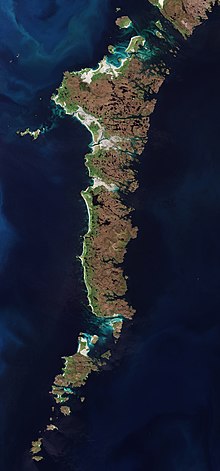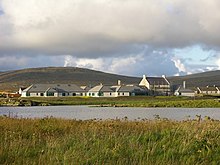Uist

Uist is a group of six islands that are part of the Outer Hebridean Archipelago, which is part of the Outer Hebrides of Scotland.
North Uist and South Uist (/ˈjuːɪst/ or /ˈuːɪst/; Scottish Gaelic: Uibhist [ˈɯ.ɪʃtʲ]) are two of the islands and are linked by causeways running via the isles of Benbecula and Grimsay.
From south to north, the inhabited islands in the island group are Èirisgeigh (Eriskay), Uibhist a Deas (South Uist), Grimsay (South), Beinn nam Faoghla (Benbecula), Eilean Fhlodaigh (Flodaigh), Griomasaigh (Grimsay (North)), Fraoch-eilean, Uibhist a Tuath (North Uist), Am Baile Sear (Baleshare) and Beàrnaraigh (Berneray).
The islands, collectively, have a population of 4,723.[1]
Major settlements
[edit]


The main settlements in Uist are:
South Uist
[edit]- Dalabrog (Daliburgh)
- Loch Baghasdail (Lochboisdale)
- Snaoishabhal (Snishvale)
- Staoinebrig (Stoneybridge)
- Iochdar (Eochar)
- Pollochar (Polochar)
- Èirisgeidh (Eriskay)
Benbecula
[edit]- Baile a' Mhanaich (Balivanich)
- Creag Ghoraidh (Creagorry)
- Lioniclate (Liniclate, Lionacleit[2])
North Uist
[edit]- Càirinis (Carinish)
- Ceann a' Bhàigh (Bayhead)
- Solas (Sollas)
- Loch nam Madadh (Lochmaddy)
- Baile Mòr (Balemore)
16th century
[edit]Geography
[edit]Writing in 1549, Sir Donald Monro, High Dean of the Isles stated of "Ywst" that it was a fertile country full of high hills and forests on the east coast with five parish kirks. He also noted that in the north of "Ywst ther is sundrie covis and holes in the earth, coverit with heddir above, quhilk fosters maney rebellis in the countrey".[3]
Fishing
[edit]Monro referred to the "infinite number of fresh water loches",[3] including Loch Bì, which is South Uist's largest loch and at eight kilometres (five miles) long it all but cuts the island in two. Monro stated that "the sea has gotten enteries to this fresche water loche" and described the "thicke dyke of rough staines" that had been created to prevent salt water ingress. This apparently resulted in numerous fish being caught in the stones, including "fluikes, podloches, skatts, and herings" and he described another "kynd of fishe, the quhantitie and shape of ane salmont, but it has na skaills at all; the under haffe, narrest his vombe is quhite, and the upmaist haffe narrest his back is als black as jett".[3]
Land tenure
[edit]Monro's description was:
This countrey is bruiked by sundrey captains; to witt, the south southwest end of it, callit Bayhastill, be M’Neill of Barray, the rest of the ile, namit Peiter’s parochin, the parochin of Howes, and the mayne land of the mid countrey callit Mackermeanache, perteins to Clanronald, halding of the Clandonald. At the end heirof the sea enters, and cuts the countrey be ebbing and flowing through it: and in the north syde of this there is ane parochin callit Buchagla, perteining to the said Clandonald. At the north end thereof the sea cuts the countrey againe, and that cutting of the sea is called Careynesse, and benorth this countrey is called Kenehnache of Ywst, that is in Englishe, the north head of Ywst, whilk term is twa paroche kirks, and is mair of profit than the rest of haill of Ywst, perteining to Donald Gormesone.[3]
See also
[edit]Bonnie Prince Charlie
[edit]Benbecula was the island from which Flora MacDonald aided the escape of Prince Charles Edward Stuart (Bonnie Prince Charlie) to Kilbride, Skye in June 1746, following his defeat at the Battle of Culloden.
Notes
[edit]- ^ National Records of Scotland (15 August 2013). "Appendix 2: Population and households on Scotland's Inhabited Islands" (PDF). Statistical Bulletin: 2011 Census: First Results on Population and Household Estimates for Scotland Release 1C (Part Two) (PDF) (Report). SG/2013/126. Retrieved 14 August 2020.
- ^ "Campuses and Centres - Benbecula". UHI North, West and Hebrides. Retrieved 6 August 2024.
- ^ a b c d Monro (1549) no. 154
References
[edit]Monro, Sir Donald (1549) Description of the Western Isles of Scotland. William Auld. Edinburgh - 1774 edition.
See also
[edit]External links
[edit]- Panoramas of Uist (QuickTime required)
- Archaeology of Uist - kite aerial photography
- Local Site Dedicated to Uist

